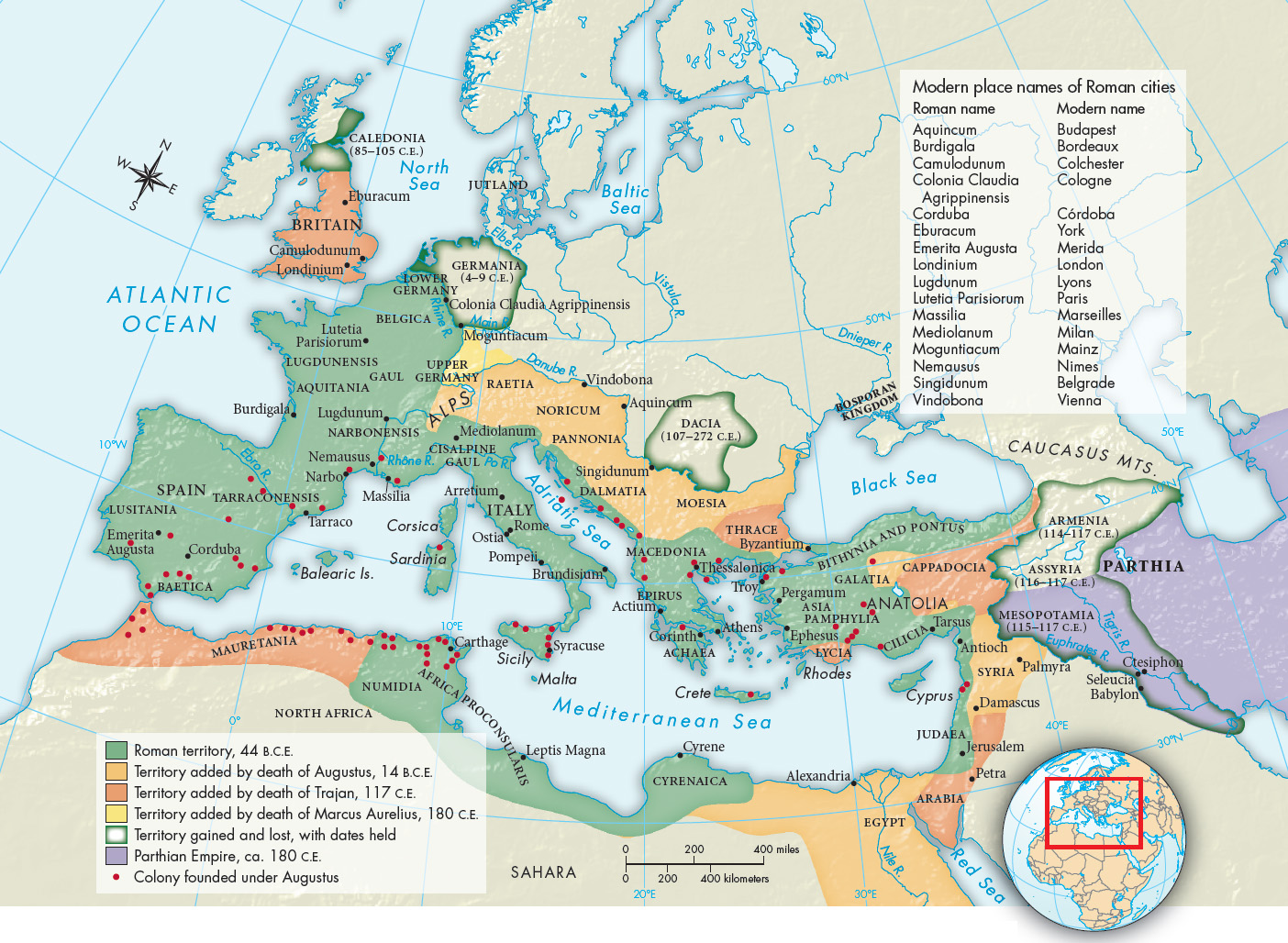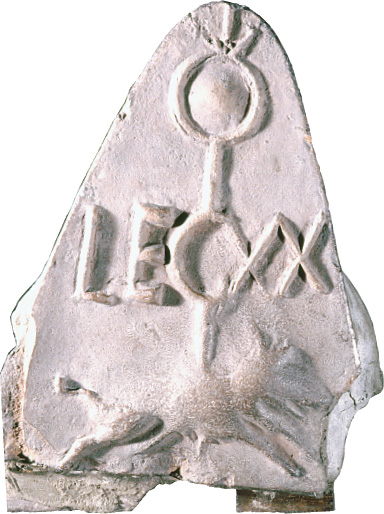A History of Western Society: Printed Page 157
A History of Western Society, Value Edition: Printed Page 161
Roman Expansion
One of the most significant aspects of Augustus’s reign was Roman expansion into northern and western Europe (Map 6.1). Augustus began his work in the west and north by completing the conquest of Spain begun by Scipio Africanus in the third century B.C.E. (see “The Punic Wars” in Chapter 5). In Gaul he founded twelve new towns, and the Roman road system linked new settlements with one another and with Italy. The German frontier along the Rhine River was the scene of hard fighting. In 12 B.C.E. Augustus ordered a major invasion of Germany beyond the Rhine. Roman legions advanced to the Elbe River, and the area north of the Main River and west of the Elbe was on the point of becoming Roman. But in 9 C.E. some twenty thousand Roman troops were annihilated at the Battle of the Teutoburg Forest and their general Varus was killed on the battlefield.

Meanwhile Roman troops penetrated the area of modern Austria, southern Bavaria, and western Hungary. Thereafter the Rhine and the Danube remained the Roman frontier in central Europe. The Romans began to build walls, forts, and watchtowers to firm up their defenses, especially in the area between the two rivers, where people could more easily enter Roman territory. The regions of modern Serbia, Bulgaria, and Romania in the Balkans fell, and the Romans created a land-based link between the eastern and western Mediterranean.
Within the area along the empire’s northern border the legionaries and auxiliaries built fortified camps. Roads linked the camps with one another, and settlements grew up around the camps. Traders began to frequent the frontier and to do business with the people who lived there. Thus Roman culture — the rough-and-ready kind found in military camps — gradually spread into the north. As a result, for the first time central and northern Europe came into direct and continuous contact with Mediterranean culture. Many Roman camps grew into cities, transforming the economy of the area around them. Roman cities were the first urban developments in most parts of central and northern Europe.
As a political and religious bond between the provinces and Rome, Augustus encouraged the cult of Roma et Augustus (Rome and Augustus) as the guardians of the state and the source of all benefits to society. In praying for the good health and welfare of the emperor, Romans and provincials were praying for the empire itself. The cult spread rapidly, especially in the eastern Mediterranean, where it built on the ideas of divine kingship developed in the Hellenistic monarchies. Worshipping Roma et Augustus became a symbol of Roman unity, and Roman officials could often judge the degree of loyalty of a province by noting the extent of public temple activities.
To make his presence felt further, Augustus had himself portrayed on coins standing alongside the goddess Victory, and on celebratory stone arches built to commemorate military victories. In addition, he had temples, stadiums, marketplaces, and public buildings constructed in Rome and other cities. Later emperors expanded this imperial cult, erecting statues, triumphal arches, columns, temples, and other buildings to honor themselves, their family members, or their predecessors. Many of these were decorated with texts as well as images. Shortly after Augustus’s death, for example, an inscription detailing his achievements, known as the Res Gestae Divi Augusti (The deeds of the divine Augustus), was carved on monuments throughout the Roman Empire. (See “Primary Source 6.1: Augustus, Res Gestae.”)

In the late eighteenth century the English historian Edward Gibbon dubbed the stability and relative peace within the empire that Augustus created the pax Romana, the “Roman peace,” which he saw as lasting about two hundred years, until the end of the reign of Marcus Aurelius in 180 C.E. Those outside the empire might not have agreed that things were so peaceful. The Roman historian Tacitus wrote of a speech delivered by the Scottish chieftain Calcagus before a battle with an invading Roman army in which Calcagus says, “The Romans make a desert and call it peace.” The speech may be an invention by Tacitus — this was a common practice for ancient historians — but it captures the idea that not everyone saw the Roman Empire as a positive force. Gibbon’s term has stuck, however, because, especially for those living away from contested frontier areas, this two-hundred-year stretch of Roman history was much more stable and prosperous than what came before or after.
The pax Romana was enforced by troops who remained on active duty or as reserves in the provinces and on the frontier, ready to respond to any resistance to Roman dominance. In general, however, Augustus respected local customs and ordered his governors to do the same. Roman governors applied Roman law to Romans living in their territories, but they let local people retain their own laws. As long as they provided taxes and did not rebel, they could continue to run their political and social lives as they had before Roman conquest.
While Romans did not force their culture on local people in Roman territories, local elites with aspirations knew that the best way to rise in stature and power was to adopt aspects of Roman culture. Thus just as ambitious individuals in the Hellenistic world embraced Greek culture and learned to speak Greek, those determined to get ahead now learned Latin, and sometimes Greek as well if they wished to be truly well educated.
Especially in cities, Roman culture blended with local traditions. The Roman city of Lugdunum, modern Lyons in southern France, provides an example of this process. The site was originally the capital of a state that had existed before the Roman conquest of Gaul, named for the Gallic god Lug. Julius Caesar made it a Roman military settlement. In 12 B.C.E. Augustus made it a political and religious center, with responsibilities for administering the area and for honoring the gods of both the Romans and Gauls. Physical symbols of this fusion of two cultures can still be seen today. The extensive remains of the amphitheater and other buildings testify to the fact that the city was prosperous enough to afford expensive Roman construction and the style of life that it represented. Many such towns were eventually granted Roman citizenship due to their embrace of Roman culture and government and their importance to the Roman economy. Ambitious young men flocked to provincial capitals such as Lugdunum, for it was here, and not in the countryside, that one could make one’s mark.